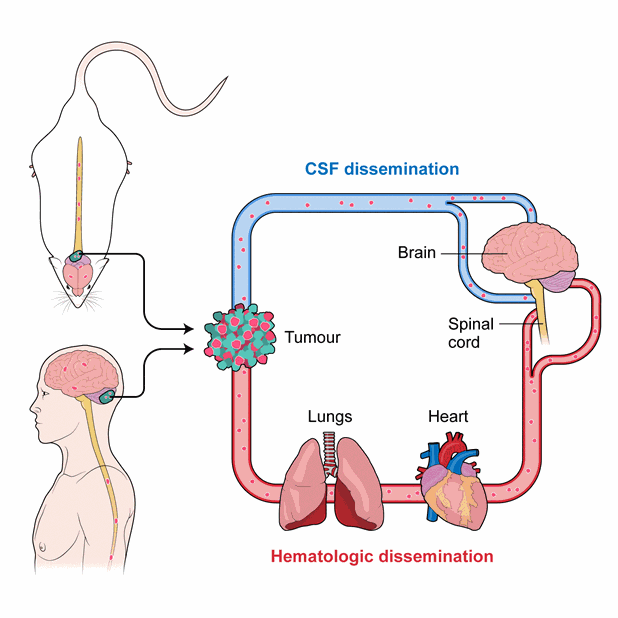
Findings from a recent study published in Cell are breaking new ground in the pediatric brain cancer world, suggesting medulloblastoma cells can metastasize in an entirely different way than previously assumed.
Medulloblastoma is a tumour of the cerebellum that frequently metastasizes to the leptomeninges of the central nervous system. It is the most common malignant childhood brain tumour, and metastasis is the leading cause of patient death.
The scientific community has historically assumed this metastasis occurred exclusively when cancer cells detached from the tumour in the cerebellum, travelling in the cerebrospinal fluid to attach and grow on the leptomeninges. Yet a recent discovery led by Dr. Michael Taylor (SickKids Hospital, Toronto) and his TFRI-funded team has shown that medulloblastoma cells can also travel from the cerebellum to the bloodstream before entering the central nervous system and forming leptomeningeal metastases. The majority of other cancers also spread through a similar hematogenous route.
With this information, new methods to detect recurrence can be devised by analyzing the circulating tumour cells in the blood of patients post-treatment. This could potentially enable clinicians to detect patients who are at higher risk of developing metastasis very early, and administer treatment more aggressively. Further, specific strategies to kill or block these cells from entering the central nervous system and forming metastasis can be designed by analyzing the circulating tumour cells.
Importantly, the team has also identified a signalling pathway that increases the tendency of medulloblastoma cells to metastasize, the CCL2/CCR2 axis. Leptomeningeal metastases express high levels of the chemokine CCL2, and expression of CCL2 in medulloblastoma can stimulate dissemination. Looking forward, this information could be utilized to design metastasis-specific precision medicine approaches for medulloblastoma.
Study: A Hematogenous Route for Medulloblastoma Leptomeningeal Metastases
Authors: Livia Garzia, Noriyuki Kijima, A. Sorana Morrissy, Pasqualino De Antonellis, Ana Guerreiro-Stucklin, Borja L. Holgado, Xiaochong Wu, Xin Wang, Michael Parsons, Kory Zayne, Alex Manno, Claudia Kuzan-Fischer, Carolina Nor, Laura K. Donovan, Jessica Liu, Lei Qin, Alexandra Garancher, Kun-Wei Liu, Sheila Mansouri, Betty Luu, Yuan Yao Thompson, Vijay Ramaswamy, John Peacock, Hamza Farooq, Patryk Skowron, David J.H. Shih, Angela Li, Sherine Ensan, Clinton S. Robbins, Myron Cybulsky, Siddhartha Mitra, Yussanne Ma, Richard Moore, Andy Mungall, Yoon-Jae Cho, William A. Weiss, Jennifer A. Chan, Cynthia E. Hawkins, Maura Massimino, Nada Jabado, Michal Zapotocky, David Sumerauer, Eric Bouffet, Peter Dirks, Uri Tabori, Poul H.B. Sorensen, Priscilla K. Brastianos, Kenneth Aldape, Steven J.M. Jones, Marco A. Marra, James R. Woodgett, Robert J. Wechsler-Reya, Daniel W. Fults, and Michael D. Taylor.
Funding: This study is supported in part by the Terry Fox Research Institute.
Links #6